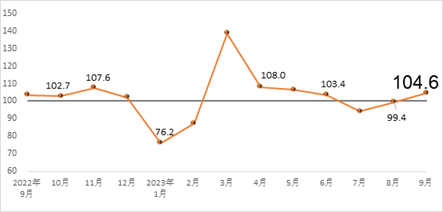official wechat
construction materials industry prosperity index (mpi) for september 2023 -z6尊龙官网入口
i. construction materials industry prosperity index in september
september 2023 construction materials industry boom index was 104.6 points, up 5.2 points from the previous month, higher than the critical point, in the boom zone, construction materials industry operation has recovered.

figure construction materials industry monthly prosperity index
on the supply side, in september, the price index and production index of the building materials industry rebounded to above the critical point. among them, the building materials industry price index 100.1 points, 1.5 points higher than last month, building materials product prices from decline to rise, a slight increase; building materials industry production index of 104.5 points, 3.8 points higher than last month, building materials product production accelerated. demand side, building materials investment demand index, industrial consumption index are higher than the critical point, international trade index is lower than the critical point. among them, building materials investment demand index 104.9 points, 5.9 points higher than last month, higher than the critical point, the building market demand rebound; building materials products industrial consumption index 104.9 points, 4.1 points higher than last month, and building materials products are more closely related to the application of the manufacturing industry demand growth; building materials international trade index of 97.7 points, 1.1 points higher than last month, lower than the critical point, the export of construction materials commodities continue to slow down.
second, mpi impact factor analysis and early warning
seasonal recovery of market demand for building materials and accelerated production of building materials in september, domestic market demand for building materials recovered. the production of key building materials continued to accelerate, cement, concrete and cement products, lime gypsum, wall materials, clay and gravel mining, building stone, construction technology glass, mineral fiber and composite materials, building sanitary ceramics and other nine industry production index rose over the previous month. enterprises on the market demand recovery is expected to enhance. product prices from decline to rise, a small increase. in the building materials 13 industries, cement, waterproof materials, lightweight building materials, thermal insulation materials, lime gypsum, clay and sand mining, construction and technical glass, building sanitary ceramics, non-metallic minerals industry and other 9 industry product price growth, price growth in the industry than last month, an increase of 7. but year-on-year, only construction and technical glass, non-metallic mineral processing industry product factory prices to maintain growth, other industry product prices are lower than the same period last year, the current building materials market is still presenting supply exceeds demand.
building materials policy is expected to improve. since august, monetary, financial and other areas of easing policy frequently, is conducive to reducing the pressure of construction project funding, accelerate the formation of physical demand, real estate policy optimization and adjustment, is conducive to marginal improvement of the real estate industry chain operating environment, building materials and other key industries such as the top ten stable growth work program intensively introduced, will form a linkage effect, and further support the building materials industry to operate stably. market expectations of the policy side continue to be good.
________________________________________
note: 1. building materials industry prosperity index (mpi) mainly monitors the running trend of the building materials industry, with a strong prediction and early warning effect. mpi higher than 100 indicates that the building materials industry is running in the boom zone, and mpi lower than 100 indicates that the building materials industry is running in the non-boom zone. 2. the building materials industry prosperity index (mpi) judges the running trend of the building materials industry from the supply side and the demand side. mpi judges the operation trend of building materials industry from the supply side and demand side. the supply side is divided into price index and production index, and the demand side is divided into investment demand index, industrial consumption index and international trade index of building materials according to the actual impact of the demand field on the building materials industry. 3. the price index of the building materials industry reflects the trend of the change of the factory price of the building materials industry. the ex-factory price does not include the expenses incurred in the circulation process of building material products, product profits and taxes. the factory price is different from the market price, the two changes will affect each other, there is a time lag, in a certain period of time there may be inconsistent changes in the trend of the situation. 4. construction materials industrial production index, reflecting changes in the trend of industrial production of construction materials, does not include price changes. 5. investment demand index, reflecting changes in the trend of market demand for investment related to construction materials. 6. industrial consumption index reflects the trend of industrial consumption demand related to building materials. the industrial consumption index reflects the trend of industrial consumption demand related to construction materials. industrial consumption, including both inter-industry consumption within the building materials industry and consumption of building materials products by downstream industries. 7. international trade index of building materials reflects the trend of changes in international trade of building materials, which is mainly composed of export indexes of building sanitary ceramics, technical glass for construction, stone for construction, glass fibers and composite materials, and non-metallic minerals, etc.
from:http://www.cbmf.org/c/2023/09/21/19367.shtml

